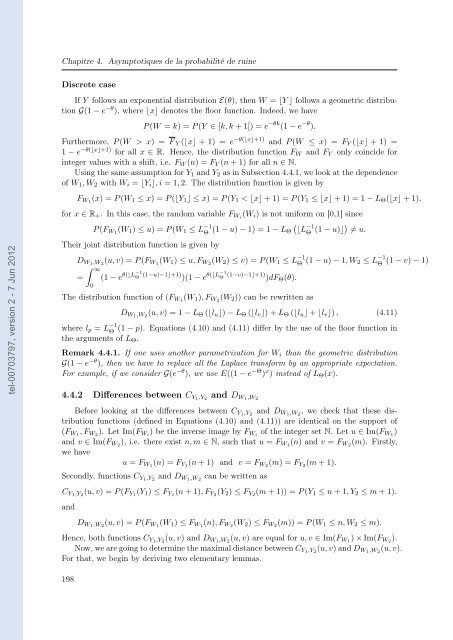Etude des marchés d'assurance non-vie à l'aide d'équilibres de ...
Etude des marchés d'assurance non-vie à l'aide d'équilibres de ...
Etude des marchés d'assurance non-vie à l'aide d'équilibres de ...
You also want an ePaper? Increase the reach of your titles
YUMPU automatically turns print PDFs into web optimized ePapers that Google loves.
tel-00703797, version 2 - 7 Jun 2012<br />
Chapitre 4. Asymptotiques <strong>de</strong> la probabilité <strong>de</strong> ruine<br />
Discrete case<br />
If Y follows an exponential distribution E(θ), then W = ⌊Y ⌋ follows a geometric distribution<br />
G(1 − e −θ ), where ⌊x⌋ <strong>de</strong>notes the floor function. In<strong>de</strong>ed, we have<br />
P (W = k) = P (Y ∈ [k, k + 1[) = e −θk (1 − e −θ ).<br />
Furthermore, P (W > x) = F Y (⌊x⌋ + 1) = e −θ(⌊x⌋+1) and P (W ≤ x) = FY (⌊x⌋ + 1) =<br />
1 − e −θ(⌊x⌋+1) for all x ∈ R. Hence, the distribution function FW and FY only coinci<strong>de</strong> for<br />
integer values with a shift, i.e. FW (n) = FY (n + 1) for all n ∈ N.<br />
Using the same assumption for Y1 and Y2 as in Subsection 4.4.1, we look at the <strong>de</strong>pen<strong>de</strong>nce<br />
of W1, W2 with Wi = ⌊Yi⌋, i = 1, 2. The distribution function is given by<br />
FW1 (x) = P (W1 ≤ x) = P (⌊Y1⌋ ≤ x) = P (Y1 < ⌊x⌋ + 1) = P (Y1 ≤ ⌊x⌋ + 1) = 1 − LΘ(⌊x⌋ + 1),<br />
for x ∈ R+. In this case, the random variable FWi (Wi) is not uniform on [0,1] since<br />
P (FW1 (W1) ≤ u) = P (W1 ≤ L −1<br />
Θ (1 − u) − 1) = 1 − LΘ<br />
Their joint distribution function is given by<br />
DW1,W2 (u, v) = P (FW1 (W1) ≤ u, FW2 (W2) ≤ v) = P (W1 ≤ L −1<br />
=<br />
∞<br />
0<br />
(1 − e θ(⌊L−1<br />
Θ (1−u)−1⌋+1) )(1 − e θ(⌊L−1<br />
Θ (1−v)−1⌋+1) )dFΘ(θ).<br />
The distribution function of (FW1 (W1), FW2 (W2)) can be rewritten as<br />
⌊L −1<br />
Θ (1 − u)⌋ = u.<br />
Θ (1 − u) − 1, W2 ≤ L −1<br />
Θ<br />
DW1,W2 (u, v) = 1 − LΘ (⌊lu⌋) − LΘ (⌊lv⌋) + LΘ (⌊lu⌋ + ⌊lv⌋) , (4.11)<br />
where lp = L −1<br />
Θ (1 − p). Equations (4.10) and (4.11) differ by the use of the floor function in<br />
the arguments of LΘ.<br />
Remark 4.4.1. If one uses another parametrization for Wi than the geometric distribution<br />
G(1 − e −θ ), then we have to replace all the Laplace transform by an appropriate expectation.<br />
For example, if we consi<strong>de</strong>r G(e −θ ), we use E((1 − e −Θ ) x ) instead of LΘ(x).<br />
4.4.2 Differences between CY1,Y2 and DW1,W2<br />
Before looking at the differences between CY1,Y2 and DW1,W2 , we check that these distribution<br />
functions (<strong>de</strong>fined in Equations (4.10) and (4.11)) are i<strong>de</strong>ntical on the support of<br />
(FW1 , FW2 ). Let Im(FWi ) be the inverse image by FWi of the integer set N. Let u ∈ Im(FW1 )<br />
and v ∈ Im(FW2 ), i.e. there exist n, m ∈ N, such that u = FW1 (n) and v = FW2 (m). Firstly,<br />
we have<br />
u = FW1 (n) = FY1 (n + 1) and v = FW2 (m) = FY2 (m + 1).<br />
Secondly, functions CY1,Y2<br />
and DW1,W2 can be written as<br />
CY1,Y2 (u, v) = P (FY1 (Y1) ≤ FY1 (n + 1), FY2 (Y2) ≤ FY2 (m + 1)) = P (Y1 ≤ n + 1, Y2 ≤ m + 1).<br />
and<br />
DW1,W2 (u, v) = P (FW1 (W1) ≤ FW1 (n), FW2 (W2) ≤ FW2 (m)) = P (W1 ≤ n, W2 ≤ m).<br />
Hence, both functions CY1,Y2 (u, v) and DW1,W2 (u, v) are equal for u, v ∈ Im(FW1 ) × Im(FW2 ).<br />
Now, we are going to <strong>de</strong>termine the maximal distance between CY1,Y2 (u, v) and DW1,W2 (u, v).<br />
For that, we begin by <strong>de</strong>riving two elementary lemmas.<br />
198<br />
(1 − v) − 1)
















